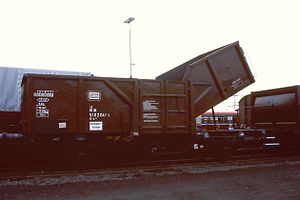Center self-unloading wagon
| DB Ommv 72 DB El-u 061 |
|
|---|---|
| Year of construction (s): | 1962- |
| Length over buffers: | 10,000 mm 10,500 mm (with handbrake) |
| Total wheelbase: | 5400 mm |
| Empty mass: | 11.5 t 11.8 t (with handbrake) |
| Loading mass: | 28.5 t 28.0 t (with handbrake) |
| Loading length: | 8700 mm |
| Loading width: | 2700 mm |
| Loading height: | 1650 mm |
| Loading area: | 23.7 m² |
| Hold: | 40.0 m³ |
Center self-unloaders were a special type of open freight car . They were developed in the 1950s to enable easy unloading of bulk goods without major technical aids. In total, the Deutsche Bundesbahn (DB) has procured almost 450 vehicles since the late 1950s. The last cars were taken out of service at the end of the 1980s.
development
After the Second World War, the railroad was still the predominant mode of transport; bulk goods played a large part in this, as around 75% of all wagon loads carried in open freight cars were bulk goods. However, the shipments could only be unloaded with wagon tipping systems, cranes or by hand. Most of the self -unloading vehicles also required expensive unloading devices (underground bunkers, etc.). Since small receivers in particular had no way of unloading the wagons cheaply, they increasingly migrated to road traffic. Therefore, new hopper cars were designed in the 1950s. In addition to floor tippers and lifting tippers , center self-unloading wagons were also designed. In contrast to other developed self-unloading wagons, the central self-unloading wagons belonged to the open freight wagons, as they had a level wagon floor. With the central self-unloading wagons, both halves of the wagon were lifted hydraulically so that the load slid into the center of the wagon, from where it could be easily unloaded via a conveyor belt.
commitment
In 1959 Talbot delivered two test cars that proved their worth. Talbot then built a first series of 50 cars. In the first half of the 1960s, the DB procured a slightly improved series with another 390 cars.
Since the wagonload traffic of small receivers without unloading devices continued to decline in the 1970s, the decommissioning of central self-unloaders began in the second half of the 1970s. The last vehicles were deleted from the inventory by DB at the end of the 1980s.
Constructive features
The underframe of the freight cars consisted of welded rolled and folded profiles made of St 52. There was a 4 mm thick sheet metal floor on the underframe. The two tiltable halves each had a head flap on the front wall. There was a two-wing revolving door on the side walls, which was firmly attached to the base.
The brakeman's platform was bolted to the corresponding vehicles.
literature
- Helmut Behrends, Wolfgang Hensel, Gerhard Wiedau: Güterwagen-Archiv 2 . transpress, Berlin 1989, ISBN 3-344-00330-5 .
